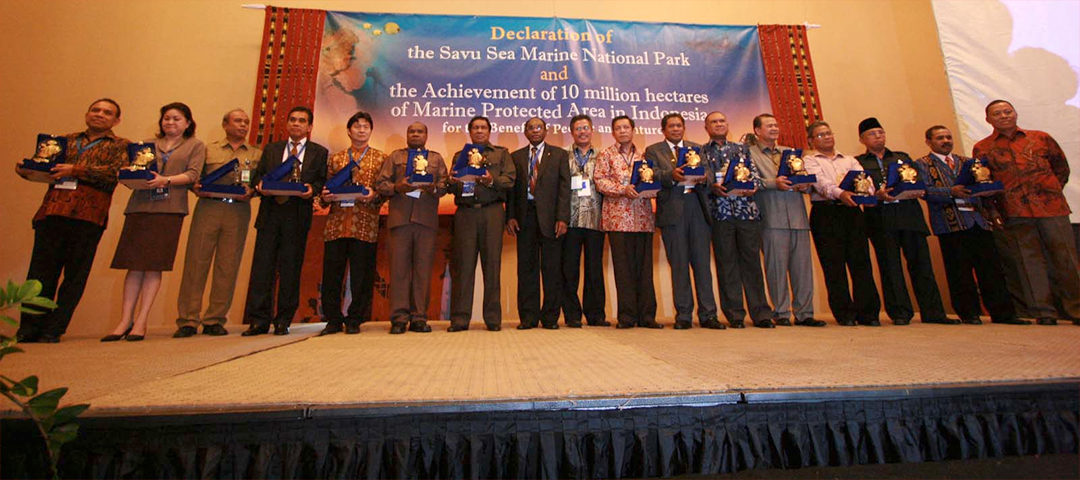The Nature Conservancy’s Indonesia marine staff recently completed a rapid ecological assessment (REA) of the Savu Sea Marine National Park, covering about one third of the total 3.3 million hectare park.
“Savu Sea in general has become a great attraction for marine scientists for unexplored species” said Dr. Syafyudin Yusuf, Hasanuddin University. For example, he and the rest of his coral research team have discovered a possible new species Montipora, a genus of stony coral, and two other species records found in Indonesian waters.
The Rapid Ecological Assessment (REA) is a survey technique designed to cover vast and data poor areas, with limited time and resources. “An REA is basically a quick assessment of what resources we are working with and a good methodology to use to confirm biodiversity hotspots identified during the initial steps of establishing the Park,” explained Gondan Renosari, Marine Program Director for TNC Indonesia Program.
Often times during an REA, ecologist will obtain the initial data for species or habitat-specific follow-up tasks to further investigate (often newly identified) conservation targets. Working in partnership across agencies and organizations, this type of field work is also a way to facilitate training and capacity building. This REA was done in 18 days by just a handful of trained observers using mostly observations done by boat covering over 1000 miles.
“The full analysis of the data collected is currently underway,” said Renosari. “Preliminary observations, however, verify that our work in the Savu Sea National Marine Park is a marine priority and that we have much work to do to protect this biodiversity hotspot for generations to come.”
Click this link to view a slideshow from the expedition! Watch the slide show.
Read 8 great observations about Savu Sea Marine National Park Coastal Baseline Resource Assessment.
- The survey started in Labuan Bajo – Flores Island (29 October 2014) and finished in Kupang – Timor Island, encompassing over 1000 miles (> 1800 km) of journey. This is approximately equal to twice the distance from Jakarta, the capital city of Indonesia, to Bali Island.
- Sea surface temperature during the survey ranged from 23°C to 30°C. The cold water originates from upwelling from near-shore deep sea feature surrounding islands of Savu Sea Marine National Park.
- This park was confirmed as an important Cetacean migratory corridor as indicated by the cetacean survey conducted in 2013. There was sighting of a herd of the rare Blue Whale, two adults and a calf, swimming very fast south along the coast past Tanjung Gemuk – Northern coast of Timor.
- There was scarcity of the formerly abundant but now rare and endangered giant clam (family Tridacnidae) at all sites surveyed in the Savu Sea. Not only has the habitat of been damaged, but the clams were also intensively exploited for meat, as evidenced by the thousands of their shells found on land, now used as salt maker bowls in many villages.
- Fish communities overall were dominated in density and biomass by three families of Acanthuridae (surgeonfishes, tangs, and unicornfishes), Scaridae (parrotfish) and Lutjanidae (snapper).
- One possible new species of butterfly-fish (Chelmon sp.) was discovered. A picture of the fish was captured by the fish team that could not be identified using any fish species guide on hand. Further genetic analysis is needed to confirm if it is actually a new species or some kind of variation of an existing species.
- Most of the sandy beaches identified on Savu Sea coasts were categorized as potential sea-turtle egg nesting beaches. However, many of the beaches were vulnerable to sea level rise.
- Sharks were rarely seen in the shallow reef habitat. Destructive fishing practices (i.e. bomb fishing) may cause their scarcity, making them go deeper to avoid disturbance. Community members have also observed and reported shark finning practices by outside groups, which would also contribute to the cause.
For more information contact the Indonesia Mapping Ocean Wealth Team

